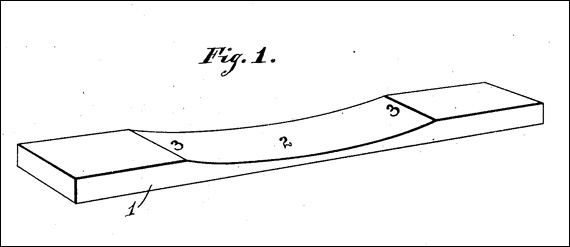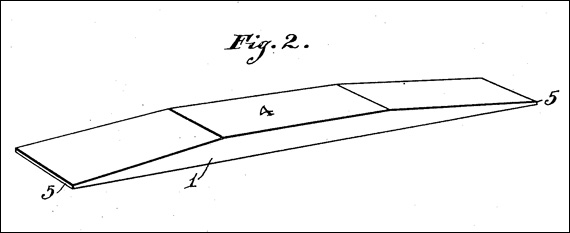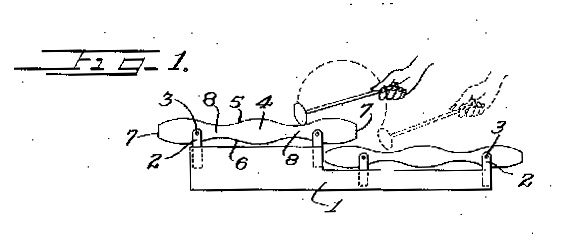In the last post we saw how "undercutting" marimba/xylophone bars opens the door to harmonic tuning -- forcing the audible overtones to align with a pitch in the harmonic series (of whatever the fundamental pitch of the bar happens to be).
It's possible that the technology of undercutting (i.e. deepening the pitch of a bar by cutting a notch in it) is pretty much universal in all musical cultures that have developed wooden bar percussion instruments. It is extremely useful for two main reasons -- 1) it makes deep-pitched bars shorter, hence instruments are smaller, lighter, more portable. And 2) it makes it much easier to tune a bar to a precise pitch. Without undercutting, a bar has to be exactly the right length (given its thickness, density,etc) to give a particular pitch. Undercutting puts an extra weapon into the tuner's hand -- if a bar is flat to the desired pitch, cut it shorter; if it's sharp, scoop out material from the middle. In practice makers soon discover that it is easier to cut all the bars so they are sharp to the desired pitch, and then approach the pitch incrementally by shaving the scoop and checking from time to time.
Accurate tuning is by no means just a modern concern -- Mandinka balafon makers tune their instruments to an equidistant heptatonic scale and may have been following this tradition for 800 years -- but harmonic tuning was as far as we know not pursued by anybody until the 1920s, when it was introduced by -- well, by whom, exactly?
I guess I've given away the answer in the title of the post ... well, maybe not THE answer, but a possible answer.
We have already discussed the Leedy/Deagan rivalry during the xylophone boom (see the previous Winterhoff post). By the 1920s the Deagan and Leedy companies were turning out large numbers of bar percussion instruments; it follows that, in their factories in Chicago and Indianapolis, there was probably a greater concentration of experienced xylo/marimba bar makers continuously at work than had ever occurred anywhere in the world before. (I don't know how many people we are talking about ... maybe ... four?) In that situation you would expect a knowledge of harmonic tuning to emerge sooner or later.
In so far as this has been discussed, the credit is mostly given to the Deagan company and their head tuner Henry Schluter.
Examples:
1) Bill Youhass of Fall Creek Marimbas says
"I believe the greatest single leap in the ongoing evolution of mallet instrument tuning was the discovery by the Deagan tuners some 80 years ago of the advantage to tuning 4th partials on marimbas and vibraphones and 3rd partials on xylophones. This revolutionized the sound of these instruments"
from The Art and Science of Mallet Instrument Tuning
-- elsewhere Youhass cites 1926 as the crucial year.
2) The Deagan Resource (a useful collection of pictures and text from old Deagan catalogues set up -- possibly -- by LA percussionist Wade Culbreath) says:
"Deagan's Chief Tuner, Henry J. Schluter, perfected harmonic tuning in wood bar instruments in 1927. Quint tuning is used for xylophone bars and is the tuning of the fundamental and the partial an octave plus a perfect fifth above the fundamental. Octave tuning is used for marimba bars and is the tuning of the fundamental and the partial two octaves above the fundamental. Before 1927, only the fundamental was tuned."
3) Century Mallet says:
"In 1927, Henry Schluter developed harmonic tuning for keyboard instruments, which is still practiced today, where applicable. In xylophones, this means quint tuning; in marimbas and vibraphones, this means octave tuning."
NB Century Mallet is the operation of Gilberto Serna, now I believe retired, who trained at Deagan and ran his own workshop in the same building at 1770 West Berteau Avenue, Chicago that had been the Deagan HQ -- the workshop is still active under Andres Bautista.
None of these people give any indication of the source of their information, but we can guess that most likely it comes ultimately from the Deagan company itself -- via personal contact, company documents, etc.
And there is the fact that post-1920s instruments (certainly those of Deagan, but from other makers too) are likely to have had harmonic tuning applied to the first overtone at least, whereas earlier instruments do not.
So, the story makes sense -- the Deagan company (chief brain, Henry J Schluter) were responsible for this "greatest single leap in the ... evolution of mallet instrument tuning".
Except ... it's rather circumstantial (i.e. basically gossip). Is there any contemporary documentation as to what people were up to (or thought they were up to)?
Well, yes -- there is a US patent; patent date June 14, 1927; that describes the advantages of harmonic tuning and succinctly summarises how it is to be done. (Well, not that succinctly, but when you've read a few patent applications you are thrilled to find an explanation that doesn't have to be read four times before you have a clue what they are talking about).
The applicant says
"Taking a bar of desired length and density and uniform thickness, the interval between the fundamental tone and the first overtone will be a musical eleventh approximately. This has been well known for many years.
A desired lower fundamental tone may be obtained from this bar by decreasing its thickness at the middle and the common manner of obtaining this decrease has been by cutting an arcuate notch in one or both faces of the bar, the shape of this cut having heretofore been largely a matter of individual taste because no attention has been paid to the resultant first overtone and therefore, heretofore, the musical interval between the resultant fundamental tone and the resultant first overtone has been a neglected variable ....
I have discovered that by proper proportioning the thickness of the bar approximately at the antinodal points of the first overtone, as compared with the thickness of the bar at the antinodal point of the fundamental tone, i. e. the middle of the bar, I can tune the first overtone so that it will be octavely spaced from the fundamental tone."
And the applicant provides a sketch (rather simpler than the ones I drew for my last post):
Two further points: the application was actually filed way back in January 1923, and the applicant was of course (as attentive readers will have predicted) Herman Winterhoff for the Leedy Company of Indianopolis.
Check out the document here.
Unless someone can turn up earlier testimony, it seems that Winterhoff has priority of invention. By his own account Winterhoff seems to have believed that no-one had even suspected the possibility of harmonic tuning before:
In the type of musical bar heretofore produced, while the bar has been gradually decreased in thickness from its ends toward its middle, no attempt has been made to octavely tune the first overtone of the bar by controlling this graduation, nor, so far as I am informed, has it been appreciated that this accurate tuning of the first overtone of the bar could be produced.
So technically, on my no doubt naive understanding of patent law, once the patent had been issued, the Leedy company were entitled to prevent anyone else in the US from using octavely-spaced harmonic tuning on their marimbas and xylophones for maybe 20 years. Obviously this did not happen.
My assumption is that they made no attempt to enforce it, but possibly there were lawsuits flying in all directions -- at this remove, how would anyone know?
Intriguingly there IS an equivalent patent issued to Henry Schluter and The Deagan company relating to quint tuning (i.e the third partial, in Bill Youhass's terminology above). It is US patent 1838502 -- which however was not applied for until 1930 (granted December 1931).
Schluter's text is less clear than Winterhoff's, but anyone who has peeped under the keys of a quint-tuned xylophone may recognise this shape: --
... which is how you cut a quint-tuned bar over some portion of the xylo range (depending upon the initial pitch of your blank, your target pitch yada yada yada).
Perhaps there was a bit of tit-for-tat? "So!! Winterhoff, you have patented octave tuning! In that case I reply with ... patented quint tuning!!!" (cackle)
.... although nobody seems to have observed the patent rights of their competitors in the slightest, as far as we know (if anyone has evidence to the contrary, it would be interesting to hear about).
My guess as to what actually happened -- is that the possibility of harmonic tuning was known to the practitioners at both companies by the early twenties. Herman Winterhoff was (possibly) the first person to formulate the issue in simple terms, and (almost certainly) the first person to document what he was doing. Neither company wanted to waste time and money in law courts, so an informal patent pool emerged (same situation may have developed with vibraphone technology, see the earlier post).
The live question at the time was surely not Who thought of this first? -- but rather, Is this worth doing? Introducing harmonic tuning would have been costly -- it would take more time to tune each instrument, the tuners would need more training, etc. The first company to make harmonic tuning standard would be at a competitive disadvantage, IF the market turned out NOT TO CARE about this kind of newfangledness. So introducing harmonic tuning is worth it if
1) the musicians out there want it, or can be encouraged to want it
and 2) it sure wouldn't hurt if your major competitor introduced it at the same time, at least you'd be in the same boat.
Of course, if you are ultra confident that your customers are going to welcome your innovation, the more incentive you have to steal a march on your competitors. If you are NOT that confident, then a tacit agreement to act together is increasingly likely, it seems to me.
Unless someone turns up some contemporary discussion in the music press, we're not going to know how it all actually happened. However it's pretty clear that the market had no objection to harmonic tuning; or perhaps all the musicians clapped their hands and skipped for joy? Anyway, before long, if you offered an instrument with fundamental tuning only, it would not have been regarded as suitable for highbrow work. Which is an advance, possibly.
****
It's interesting that both patent applications include some pleasantly crackpot ideas. Winterhoff proposes bars with single-octave tuning, which would naturally have to be cut rather like this --
... and Schluter proposes xylo bars with the wavy notch cut on the upper- as well as the under-side, like this:
and claims that musical effects could be obtained from striking the bar on the declivities (bringing out the harmonics, possibly), a helpful sketch shows how:
NB I don't call these notions "crackpot" because they are wrong; in fact they are both quite correct, but like most innovative ideas that fall by the wayside, they were deemed to be not worth the trouble of implementing, for reasons which I leave as an exercise to the reader.






